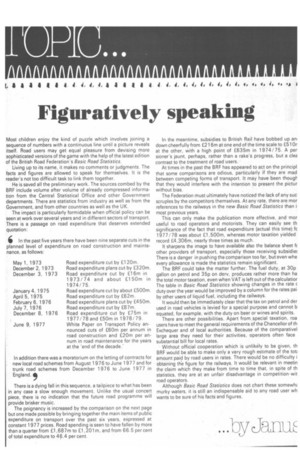Figuratively speaking
Page 50

If you've noticed an error in this article please click here to report it so we can fix it.
Most children enjoy the kind of puzzle which involves joining a sequence of numbers with a continuous line until a picture reveals itself. Road users may get equal pleasure from devising more sophisticated versions of the game with the help of the latest edition of the British Road Federation's Basic Road Statistics.
Living up to its name, it makes no comments or judgments. The facts and figures are allowed to speak for themselves. It is the reader's not too difficult task to link them together_ He is saved all the preliminary work. The sources combed by the BRF include volume after volume of already compressed information from the Central Statistical Office and other Government departments. There are statistics from industry as well as from the Government, and from other countries as well as the UK.
The impact is particularly formidable when official policy can be seen at work over several years and in different sectors of transport. There is a passage on road expenditure that deserves extended quotation: In the past five years there have been nine separate cuts in the planned level of expenditure on road construction and maintenance, as follows: May 1, 1973 Road expenditure cut by £120m.
December 2, 1973 Road expenditure plans cut by E320m.
December 3, 1973 Road expenditure cut by £16m in 1973 / 74 and about £150m in 1974/ 75.
January 4, 1975 Road expenditure cut by about E500m.
April 5, 1975 Road expenditure cut by £62m.
February 6. 1976 Road expenditure plans cut by £450m.
July 7, 1976 Road expenditure cut by £87m.
December 8, 1976 Road expenditure cut by £75m in 1977/78 and £50m in 1978/79 June 9, 1977 White Paper on Transport Policy an nounced cuts of £60m per annum in road construction and £20m per annum in road maintenance for the years at the 'end of the decade.'
In addition there was a moratorium on the letting of contracts for new local road schemes from August 1976 to June 1977 and for trunk road schemes from December 1976 to June 1977 in England.
There is a dying fall in this sequence, a tailpiece to what has been in any case a slow enough movement. Unlike the usual concert piece, there is no indication that the future road programme will provide brisker music.
The poignancy is increased by the comparison on the next page but one made possible by bringing together the main items of public expenditure on transport over the past six years, expressed at constant 1977 prices. Road spending is seen to have fallen by more than a quarter from £1,687m to £1,201m, and from 66.5 per cent of total expenditure to 46.4 per cent. In the meantime, subsidies to British Rail have bobbed up an down cheerfully from £216m at one end of the time scale to £510r at the other, with a high point of £635m in 1974/75. A per sioner's jaunt, perhaps, rather than a rake's progress, but a clea contrast to the treatment of road users.
At times in the past the BRF has appeared to act on the principl that some comparisons are odious, particularly if they are mad between competing forms of transport. It may have been though that they would interfere with the intention to present the pictur without bias.
The Federation must ultimately have noticed the lack of any suc scruples by the competitors themselves. At any rate, there are mor references to the railways in the new Basic Road Statistics than i most previous years.
This can only make the publication more effective, and mor useful to road operators and motorists. They can easily see th significance of the fact that road expenditure (actual this time) fc 1977/78 was about E1,500m, whereas motor taxation yielded record £4,306m, nearly three times as much.
It sharpens the image to have available also the balance sheet ft other providers of transport, especially those receiving subsidie There is a danger in pushing the comparison too far, but even whe every allowance is made the statistics remain significant.
The BRF could take the matter further. The fuel duty, at 30p gallon on petrol and 35p on derv, produces rather more than ha the total motor taxation, even when VAT is left out of the calculatior The table in Basic Road Statistics showing changes in the rate c duty over the year would be improved by a column for the rates pai by other users of liquid fuel, including the railways.
It would then be immediately clear that the tax on petrol and der used in road vehicles is levied for a special purpose and cannot b equated, for example, with the duty on beer or wines and spirits.
There are other possibilities. Apart from special taxation, roa users have to meet the general requirements of the Chancellor of th Exchequer and of local authorities. Because of the comparativel large area they need for their activities, operators often face substantial bill for local rates.
Without official cooperation which is unlikely to be given, th BRF would be able to make only a very rough estimate of the toti amount paid by road users in rates. There would be no difficulty i obtaining the figure for the railways. It would be relevant in meetin the claim which they make from time to time that, in spite of th statistics, they are at an unfair disadvantage in competition•wit road operators.
Although Basic Road Statistics does not chart these somevvh murky waters, it is still an indispensable aid to any road user wh wants to be sure of his facts and figures.




















































































